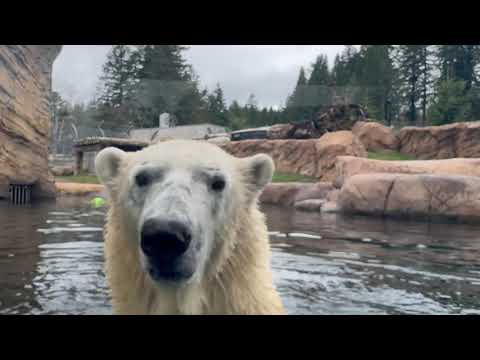- Nora, the polar bear, interacts with her environment, showcasing behavioral enrichment in zoo settings.
- The role of zoos in wildlife conservation and education through engaging experiences such as animal interactions.
- Understanding polar bear biology and the implications of their behaviors in captivity.
- The impact of technology in observing and enhancing animal welfare and research.
- Conservation challenges faced by polar bears in the wild and the role zoos play in mitigating these threats.
Polar Bear Nora has become an unofficial ambassador for the natural curiosity and adaptability of her species. Her interaction with a submerged camera in her pool provides a fascinating glimpse into how polar bears engage with their managed environments. Nora’s actions highlight critical themes in zoology, zoo management, and wildlife conservation, offering insights into the complex world of polar bears and how they are cared for in zoological settings.
Polar bears, or Ursus maritimus, are known for their intelligence and playfulness, traits that have been well-documented in both wild and captive settings. In zoos, providing behavioral enrichment is essential to mirror the natural environments and experiences that animals like Nora would encounter in the wild. The presence of a camera underwater can unexpectedly serve as a source of enrichment, sparking curiosity and mimicking the exploratory behavior polar bears frequently display in their native tundra and icy waters. This incident not only entertains but also serves as an educational tool, demonstrating how simple environmental changes stimulate mental and physical activity in animals.
Zoos worldwide play a pivotal role in wildlife conservation, serving as centers for research and education. They facilitate a connection between people and animals, fostering an appreciation for wildlife and the urgent need for conservation efforts. By observing animals like Nora engage actively with their surroundings, zoo visitors can better understand the significance of animal welfare and environmental protection. Such experiences are invaluable in highlighting zoos’ roles beyond mere exhibition spaces; they function as guardians and advocates for endangered species, contributing to broader conservation goals.
Understanding the biology and behavior of polar bears such as Nora is crucial for optimally managing their care in captivity. Polar bears are adapted to cold environments, with specialized fur and fat layers providing insulation. They are skilled swimmers, often traveling long distances in search of food, primarily seals. In captivity, replicating these natural conditions as closely as possible ensures the animals remain physically fit and mentally stimulated. Nora’s fascination with underwater objects like a camera presents an opportunity for zoo management to adapt to her behaviors and preferences, enhancing her living environment and promoting natural behaviors.
Technology has increasingly played a role in the study of animal behavior and welfare, providing tools that allow researchers to observe animals in new ways without causing disruption. Cameras, for instance, enable the documentation of spontaneous interactions and natural behaviors, offering data that contribute to research on animal cognition, emotion, and social dynamics. The ability to record and analyze such interactions provides insights into how captive environments can be modified to support more authentic experiences for the animals, promoting psychological well-being and potentially contributing to enhanced reproductive success.
In examining polar bear conservation, it is essential to consider the environmental challenges these animals face in the wild. Climate change has drastically affected the Arctic ecosystem, diminishing ice habitats crucial for their survival. Polar bears rely on sea ice to hunt and breed, and its reduction poses a severe threat to their population. Zoos, therefore, serve as critical not just for research but also as advocates for change, actively participating in breeding programs and educational campaigns to raise awareness about climate change’s impact on the Arctic and its inhabitants.
By providing an engaging platform through which the public can learn about these majestic animals, zoos encourage proactive involvement in conservation efforts. Understanding that creatures like Nora depend on advocacy and the implementation of climate strategies underlines the urgency of collective action.
In this ever-advancing age, the importance of responsible zoo management cannot be understated. By utilizing technology, fostering educational experiences, and prioritizing animal welfare, modern zoos can play an instrumental role in conserving species like the polar bear. Nora’s playful dive into her pool serves as a reminder of the deep connections between animal behavior and environmental enrichment, illustrating the impactful work conducted within the zoo community. Through education and innovation, we gain valuable insights into the world of wildlife, paving the way for a sustainable future in conservation efforts.
*****
Source Description
Polar plunge!
Polar bear Nora loves to dive, so care staff came up with a way to safely place a camera at the bottom of her pool to watch her underwater. Beary cool!


